Features
CPUs
| | This section is empty. You can help by adding to it. (March 2023) |
| General information | |
|---|---|
| Launched | May 15, 2012 |
| Common manufacturer | |
| Architecture and classification | |
| Technology node | 32 nm SOI GF |
| Instruction set | AMD64 (x86-64) |
| Physical specifications | |
| Sockets |
|
| Products, models, variants | |
| Core names | |
| History | |
| Predecessor | Bulldozer - Family 15h |
| Successor | Steamroller - Family 15h (3rd-gen) |
| Support status | |
| iGPU unsupported | |
AMD Piledriver Family 15h is a microarchitecture developed by AMD as the second-generation successor to Bulldozer. It targets desktop, mobile and server markets. It is used for the AMD Accelerated Processing Unit (formerly Fusion), AMD FX, and the Opteron line of processors.
The changes over Bulldozer are incremental. Piledriver uses the same "module" design. Its main improvements are to branch prediction and FPU/integer scheduling, along with a switch to hard-edge flip-flops to improve power consumption. This resulted in clock speed gains of 8–10% and a performance increase of around 15% with similar power characteristics. [1] FX-9590 is around 40% faster than Bulldozer-based FX-8150, mostly because of higher clock speed.[ citation needed ]
Products based on Piledriver were first released on 15 May 2012 with the AMD Accelerated Processing Unit (APU), code-named Trinity, series of mobile products. [2] APUs aimed at desktops followed in early October 2012 with Piledriver-based FX-series CPUs released later in the month. [3] [4] Opteron server processors based upon Piledriver were announced in early December 2012. [5]
Piledriver includes improvements over the original Bulldozer microarchitecture: [6] [7]
| | This section is empty. You can help by adding to it. (March 2023) |
| Model | CPU | GPU | TDP (W) | DDR3 Memory | Turbo Core 3.0 | Socket | ||||||
|---|---|---|---|---|---|---|---|---|---|---|---|---|
| [Modules/FPUs] Cores/threads | Freq. (GHz) | Cache | Model | Config | Freq. (MHz) | |||||||
| Base | Turbo | L2 | L3 | |||||||||
| FX-9590 | [4]8 | 4.7 | 5.0 | 4× 2MB | 8MB | — | 220 | 1866 | Yes | AM3+ | ||
| FX-9370 | 4.4 | 4.7 | ||||||||||
| FX-8370 | 4.0 | 4.3 | 125 | |||||||||
| FX-8370E | 3.3 | 95 | ||||||||||
| FX-8350 | 4.0 | 4.2 | 125 | |||||||||
| FX-8320 | 3.5 | 4.0 | ||||||||||
| FX-8320E | 3.2 | 95 | ||||||||||
| FX-8310 | 3.4 | 4.3 | 95 | |||||||||
| FX-8300 | 3.3 | 4.2 | 95 | |||||||||
| FX-6350 | [3]6 | 3.9 | 4.2 | 3× 2MB | 125 | |||||||
| FX-6300 | 3.5 | 4.1 | 95 | |||||||||
| FX-4350 | [2]4 | 4.2 | 4.3 | 2× 2MB | 125 | |||||||
| FX-4320 | 4.0 | 4.2 | 4MB | 95 | ||||||||
| FX-4300 | 3.8 | 4.0 | ||||||||||
| A10-6800K | 4.1 | 4.4 | — | HD 8670D | 384:24:8 | 844 | 100 | 2133 | FM2 | |||
| A10-6700 | 3.7 | 4.3 | 65 | 1866 | ||||||||
| A10-5800K | 3.8 | 4.2 | HD 7660D | 800 | 100 | |||||||
| A10-5700 | 3.4 | 4.0 | 760 | 65 | ||||||||
| A8-6600K | 3.9 | 4.2 | HD 8570D | 256:16:8 | 844 | 100 | ||||||
| A8-6500 | 3.5 | 4.1 | 800 | 65 | ||||||||
| A8-5600K | 3.6 | 3.9 | HD 7560D | 760 | 100 | |||||||
| A8-5500 | 3.2 | 3.7 | 65 | |||||||||
| A6-6400K | [1]2 | 3.9 | 4.1 | 1MB | HD 8470D | 192:12:4 | 800 | |||||
| A6-5400K | 3.6 | 3.8 | HD 7540D | 760 | ||||||||
| A4-5300 | 3.4 | 3.6 | HD 7480D | 128:8:4 | 723 | 1600 | ||||||
| A4-4000 | 3.0 | 3.2 | 1333 | |||||||||
The K suffix denotes an unlocked A-series processor. All FX-series processors are unlocked unless otherwise specified.

| Model | CPU | GPU | TDP (W) | DDR3 Memory | Socket | ||||||
|---|---|---|---|---|---|---|---|---|---|---|---|
| [Modules/FPUs] | Freq.(GHz) | L2 Cache (MB) | Model | Config | Freq.(GHz) | ||||||
| Base | Turbo | Base | Turbo | ||||||||
| A10-5750M | [2]4 | 2.5 | 3.5 | 2× 2MB | HD 8650G | 384:24:8 | 533 | 720 | 35 | 1866 | FS1r2 |
| A10-4600M | 2.3 | 3.2 | HD 7660G | 496 | 685 | ||||||
| A8-5550M | 2.1 | 3.1 | HD 8550G | 256:16:8 | 554 | 720 | |||||
| A8-4500M | 1.9 | 2.8 | HD 7640G | 496 | 685 | ||||||
| A6-5350M | [1]2 | 2.9 | 3.5 | 1 | HD 8450G | 192:12:4 | 533 | 720 | 1600 | ||
| A6-4400M | 2.7 | 3.2 | HD 7520G | 496 | 685 | ||||||
| A4-5150M | 3.3 | HD 8350G | 128:8:4 | 514 | 720 | ||||||
| A4-4300M | 2.5 | 3.0 | HD 7420G | 480 | 655 | ||||||
| A10-5757M | [2]4 | 2.5 | 3.5 | 2× 2MB | HD 8650G | 384:24:8 | 533 | 720 | 35 | 1600 | FP2(BGA) |
| A10-5745M | 2.1 | 2.9 | HD 8610G | 626 | 25 | 1333 | |||||
| A10-4655M | 2.0 | 2.8 | HD 7620G | 360 | 496 | ||||||
| A8-5557M | 2.1 | 3.1 | HD 8550G | 515 | 720 | 35 | 1600 | ||||
| A8-5545M | 1.7 | 2.7 | HD 8510G | 450 | 554 | 19 | 1333 | ||||
| A8-4555M | 1.6 | 2.4 | HD 7600G | 320 | 424 | ||||||
| A6-5357M | [1]2 | 2.9 | 3.5 | 1 | HD 8450G | 192:12:4 | 533 | 720 | 35 | 1600 | |
| A6-5345M | 2.2 | 2.8 | HD 8410G | 450 | 600 | 17 | 1333 | ||||
| A6-4455M | 2.1 | 2.6 | HD 7500G | 256:16:8 | 327 | 424 | |||||
| A4-5145M | 2.0 | HD 8310G | 192:12:4 | 424 | 544 | ||||||
| A4-4355M | 1.9 | 2.4 | HD 7400G | 327 | 424 | ||||||
Some Opteron 32 nm processors.
Leaked roadmaps showed Piledriver CPUs featuring up to ten cores as part of the Komodo platform. Komodo was to launch in 2012 on the FM2 socket, but this never happened. AMD kept the AM3+ socket for the FX series and put the Piledriver-based APUs on FM2. [12]
In 2010 [13] AMD revealed that the 2nd generation was scheduled for 2012; AMD referred to this generation as Enhanced Bulldozer. This later generation of Bulldozer core was codenamed Piledriver.
On June 11, 2013, AMD announced two additional FX-series eight Piledriver core CPUs, the FX-9590 and FX-9370, running at a maximum turbo speed of 5.0 GHz and 4.7 GHz respectively, making AMD the first company to ever release a 5 GHz CPU commercially. [19] AMD specify that the 9xxx series processors require "robust liquid cooling" due to their high Thermal Design Power (TDP) [20]
For the server market, three versions were stated to be under development: [26]
In January 2013, AMD officially introduced a new series of APUs codenamed Richland. [32] The series features six new APUs in total. The fastest model, the A10-6800K, featured two Piledriver modules operating at 4.1 GHz and 4.4 GHz in turbo mode and an integrated HD 8670D GPU with 384 stream processors operating at 844 MHz. [33] [34] Only the A10-6800K has official DDR3-2133 memory support. [35] The A10-6800K offered approximately 5% performance improvements in performance applications and 3D games over its A10-5800K Trinity based predecessor, largely due to Richland's higher clock speeds and higher overclocking potential than Trinity. On March 12, 2013, AMD officially introduced four Richland mobile APUs. [36] On June 4, 2013, AMD officially announced six Richland desktop APUs. [37] [38]
In January 2012, Microsoft released two hotfixes (2646060 and 2645594) for Windows 7 and Server 2008 R2 that significantly improved the performance of Clustered Multi-Thread based AMD CPUs by improving thread scheduling. [39] [40]
Windows 8 supports CMT-based CPUs out of the box by addressing each core as logical cores and modules as physical cores.

Advanced Micro Devices, Inc. (AMD) is an American multinational corporation and fabless semiconductor company based in Santa Clara, California, that designs, develops and sells computer processors and related technologies for business and consumer markets.
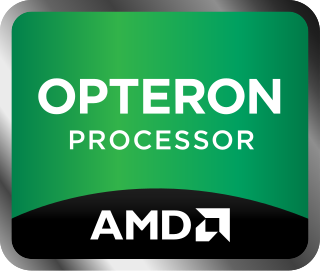
Opteron is AMD's x86 former server and workstation processor line, and was the first processor which supported the AMD64 instruction set architecture. It was released on April 22, 2003, with the SledgeHammer core (K8) and was intended to compete in the server and workstation markets, particularly in the same segment as the Intel Xeon processor. Processors based on the AMD K10 microarchitecture were announced on September 10, 2007, featuring a new quad-core configuration. The last released Opteron CPUs are the Piledriver-based Opteron 4300 and 6300 series processors, codenamed "Seoul" and "Abu Dhabi" respectively.

The Socket AM2, renamed from Socket M2, is a CPU socket designed by AMD for desktop processors, including the performance, mainstream and value segments. It was released on May 23, 2006, as a replacement for Socket 939.
The AMD Family 10h, or K10, is a microprocessor microarchitecture by AMD based on the K8 microarchitecture. The first third-generation Opteron products for servers were launched on September 10, 2007, with the Phenom processors for desktops following and launching on November 11, 2007 as the immediate successors to the K8 series of processors.
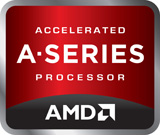
AMD Accelerated Processing Unit (APU), formerly known as Fusion, is a series of 64-bit microprocessors from Advanced Micro Devices (AMD), combining a general-purpose AMD64 central processing unit (CPU) and 3D integrated graphics processing unit (IGPU) on a single die.
The AMD Bulldozer Family 15h is a microprocessor microarchitecture for the FX and Opteron line of processors, developed by AMD for the desktop and server markets. Bulldozer is the codename for this family of microarchitectures. It was released on October 12, 2011, as the successor to the K10 microarchitecture.

The Socket FS1 is for notebooks using AMD APU processors codenamed Llano, Trinity and Richland.
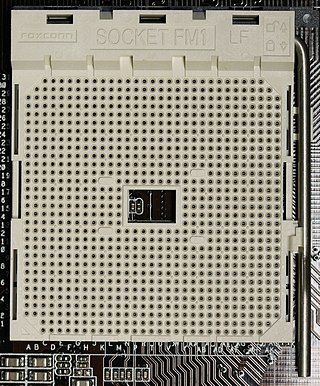
Socket FM1 is a CPU socket for desktop computers used by AMD early A-series APUs ("Llano") processors and Llano-derived Athlon II processors. It was released in July 2011. Its direct successors are Socket FM2 and Socket FM2+, while Socket AM1 is targeting low-power SoCs.

Socket FM2 is a CPU socket used by AMD's desktop Trinity and Richland APUs to connect to the motherboard as well as Athlon X2 and Athlon X4 processors based on them. FM2 was launched on September 27, 2012. Motherboards which feature the at the time new FM2 CPU socket also utilize AMD's at the time new A85X chipset.

AMD FX are a series of high-end AMD microprocessors for personal computers which debuted in 2011, claimed as AMD's first native 8-core desktop processor. The line was introduced with the Bulldozer microarchitecture at launch, and was then succeeded by its derivative Piledriver in 2012.
AMD Steamroller Family 15h is a microarchitecture developed by AMD for AMD APUs, which succeeded Piledriver in the beginning of 2014 as the third-generation Bulldozer-based microarchitecture. Steamroller APUs continue to use two-core modules as their predecessors, while aiming at achieving greater levels of parallelism.
AMD Excavator Family 15h is a microarchitecture developed by AMD to succeed Steamroller Family 15h for use in AMD APU processors and normal CPUs. On October 12, 2011, AMD revealed Excavator to be the code name for the fourth-generation Bulldozer-derived core.
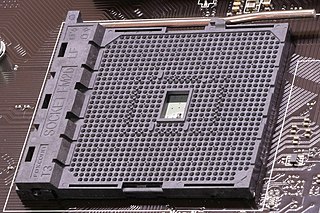
Socket FM2+ is a zero insertion force CPU socket designed by AMD for their desktop "Kaveri" APUs (Steamroller-based) and Godavari APUs (Steamroller-based) to connect to the motherboard. The FM2+ has a slightly different pin configuration to Socket FM2 with two additional pin sockets. Socket FM2+ APUs are not compatible with Socket FM2 motherboards due to the aforementioned additional pins. However, socket FM2 APUs such as "Richland" and "Trinity" are compatible with the FM2+ socket.
The Socket FP2 or μBGA-827 is a CPU socket for notebooks that was released in May 2012 by AMD with its APU processors codenamed Trinity and Richland.
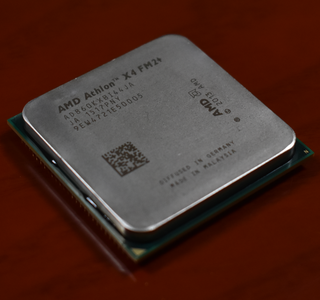
AMD Athlon X4 is a series of budget AMD microprocessors for personal computers. These processors are distinct from A-Series APUs of the same era due to the lack of iGPUs.